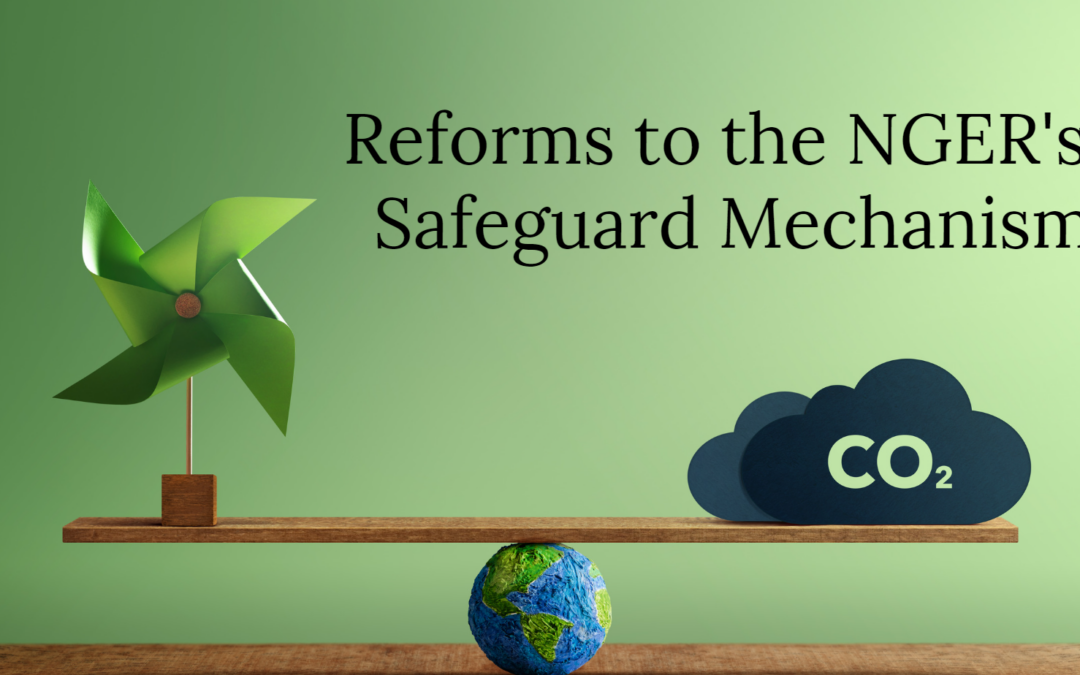As climate change starts to create a more visible impact across the planet, Australia is committed to looking at ways to reduce greenhouse gas emissions across the country. In support of Australia’s COP 27 commitments, the Federal Government has proposed that by 2050, Australia will reach net zero emissions. To achieve this target, the Federal Government is proposing reforms to the National Greenhouse and Energy Reporting (NGER) scheme and its Safeguard Mechanism to reduce the emissions from Australia’s largest greenhouse gas emitters. These changes will commence on the 1st July, 2023 (Department of Climate Change, Energy, the Environment and Water, 2023b). By 2030, it is estimated that the changes to the safeguard mechanism will prevent 205 million tonnes of Carbon Dioxide equivalent (CO2-e) from being released into the environment (Figure 1) (Department of Climate Change, Energy, the Environment and Water, 2023b).

Figure 1 Projected trajectory to reach net zero by 2050
Source: Department of Climate Change, Energy, the Environment and Water, 2023b
National Greenhouse and Energy Reporting scheme
The NGER scheme is a national framework for companies to report greenhouse gas emissions, energy production, and energy consumption. This framework is designed to (1) inform the Australian public, (2) assist Australia in meeting their international reporting obligations, and (3) track the progress towards net zero emissions by 2050. A Company is required to report their Greenhouse Emission if they operate:
- A Facility that generates 25 kt or more of greenhouse gases (CO2-e) (Scope 1 and Scope 2 emissions) or produces or consumes 100 TJ or more of energy and/or
- A series of facilities or their activities exceed 50 kt or more of greenhouse gases (CO2-e) (Scope 1 and Scope 2 emissions) or produce or consume 200 TJ or more of energy (Clean Energy Regulator, 2022a).
As defined in the National Greenhouse and Energy Reporting Regulations 2008 act, ‘Scope 1’ emissions are emissions released directly from the activities undertaken by a facility. ‘Scope 2’ emissions are emissions released as a result of energy generation at another location that is purchased and consumed consumption by a facility, otherwise known as indirect emissions.
What is the Safeguard Mechanism?
The Safeguard Mechanism requires Australia’s largest greenhouse gas emitters to keep their net emissions below an emissions limit (a baseline). The Australian Government proposes to (Clean Energy Regulator, 2022c):
- gradually reduce baselines to help Australia reach net zero emissions by 2050
- introducing credits for facilities that emit less than their baseline, and
- providing tailored treatment to emissions-intensive, trade-exposed facilities, so businesses are not disadvantaged compared to international competitors and emissions do not increase overseas.
The safeguard mechanism applies to facilities with ‘Scope 1’ that exceeds 100,000 t CO2-e per year (National Greenhouse and Energy Reporting (Safeguard Mechanism) Rule 2015, Cth). The safeguard mechanism requires large emitters to submit their predicted estimated ‘Scope 1’ emissions for the financial year to the Clean Energy Regulator (CER). Once approved, this will become the baseline for the facility to keep their ‘Scope 1’ emissions below. If facilities exceed their baseline, they must acquire and surrender Australian Carbon Credit Units (ACCUs) to cover the emissions exceeding their established baseline.
Large emitters are required to register to the CER by 31st August of the year; following the first financial year, the facility exceeds 100,000 t CO2-e ‘Scope 1’ emission (Clean Energy Regulator, 2022c).
What is a Facility Baseline?
Under the safeguard mechanism, facilities are given a baseline, which is the reference point against which net emissions levels will be assessed. A safeguard facility must keep its net emissions levels at or below its baseline (Clean Energy Regulator, 2022b).
The baseline threshold is 100,000 t CO2-e of ‘Scope 1’ emissions. Facilities exceeding this baseline can apply for the safeguard mechanism, which they can be given their own baseline, which is calculated through different methods. Prior to the proposed 2022 changes to the safeguard mechanism, there were four accepted methods for estimating a baseline. These are (Clean Energy Regulator, 2022b):
- Production-adjusted baselines
- Calculated based on actual production levels multiplied by an intensity factor. This can be set at the year with the highest production level during the benchmark or calculated period or adjusted annually.
- Calculated baselines
- Calculated based on a forecast of production levels and either a default intensity factor can be used or site-specific.
- Benchmark baselines
- Calculated based on the best practice emission-intensive factor based on production forecasts.
- Reported baselines
- Calculated based on the highest historical reported ‘Scope 1’ emission between 2009-10 and 2013-14. This framework stopped being used as of 1st July 2021.
Proposed Safeguard Mechanism Reforms
The 2022-23 safeguard mechanism reforms proposed a change in how the safeguard baselines are being determined. Almost all current baseline estimation methods are being scrapped except for the production-adjusted baseline. A production-adjusted baseline will still be accepted with the new safeguard reform to allow the baseline to fluctuate based on the production levels based on intensity factors. For operations currently using the Calculated, Benchmark or Reported baseline will be required to either move to production-adjusted or the new hybrid method, which is a mixture of a production-adjusted baseline and a site-specific level baseline. The hybrid approach will transition to the industry average baseline approach by 2030 (Department of Climate Change, Energy, the Environment and Water, 2023b). The proposed safeguard reforms can be found located on the DCCEEW website (Figure 2).


Figure 2 Safeguard Mechanism Reforms
Source: Department of Climate Change, Energy, the Environment and Water, 2023b
Multi-year monitoring will still be available for eligible facilities. Multi-year monitoring is currently available for a maximum of three years. To be eligible, a facility has to prove that the following year’s emissions will equal a net average baseline below their baseline. The new multi-year monitoring being proposed will be extended to a maximum of five years, and facilities will need to prove that their facility exceeded their baseline due to a lack of technology available (Department of Climate Change, Energy, the Environment and Water, 2023b). With new technology becoming available, it is estimated that many facilities will be able to reduce their emissions below the projected rate (Figure 3).

Figure 3 Projected trajectory of a facility’s emissions with and without new technology
Source: Department of Climate Change, Energy, the Environment and Water, 2023b
Prior to the proposed changes, baseline emission levels were not required to reduce each year, as a result, facilities were not expected to reduce their net emissions. With the proposed changes to the safeguard mechanism, baselines will need to be reduced by 4.9% per year until 2030. This will force facilities to work towards reducing their emissions and allow emissions in Australia to meet the projected 43% reduction by 2030, based on the 2005 levels. The reduction rate between 2030-2035 will be outlined in the 2027 safeguard assessment. It is expected that by 2050, facilities will have reduced their emissions to zero or acquire Carbon Offsets or Credits to enable them to achieve Net Zero Emissions (Department of Climate Change, Energy, the Environment and Water, 2023b).
Changes to the Safeguard Mechanism: EITE
Emissions-intensive, trade-exposed (EITE) eligible facilities will come under two categories. Category 1 is trade-exposed facilities which covers about 80% of participants and uses an activity-based assessment. The second is trade-exposed, baseline-adjusted facilities which covers facilities that have a higher risk of carbon leakage overseas. These facilities are subsets of trade-exposed facilities (Department of Climate Change, Energy, the Environment and Water, 2023b). The proposed changes that are occurring around EITEs are based on the activities assessment. Facilities that are covered by EITE will be assessed on a case-by-case scenario to ensure these facilities remain competitive and reduce the risk of emissions ‘leaking’ overseas. A proposed way of calculating the risk of emissions ‘leaking’ overseas, is the scheme cost multiplied by the revenue of the facility (Department of Climate Change, Energy, the Environment and Water, 2023b). The scheme cost is calculated by the exceedance of the facility to their baseline multiplied by the default certificate price of the safeguard mechanism (Department of Climate Change, Energy, the Environment and Water, 2023b). The default certificate price is estimated based on the price of certificates if the facility had chosen to purchase any to reduce their emissions. Funding has been budgeted to support EITE facilities reduce their emissions by supporting decarbonisation activities (Department of Climate Change, Energy, the Environment and Water, 2023b).
Changes to the Safeguard Mechanism: Carbon Credits
Currently, ACCUs can be generated from eligible Emission Reduction Funds (ERF) projects. They can then be used by the facility to reduce the ‘Scope 1’ emissions to meet their baseline, or traded to another facility. Currently, there is only a limited number of ACCUs that can be purchased and sold due to the limited number of ERF projects. This means that the prices of ACCUs can fluctuate greatly depending on stock levels.
There are a few changes planned for ACCUs. Safeguard facilities will no longer be able to generate ACCUs from new or ERF projects, and those on current contracts will no longer be renewed. However, facilities are still able to register these projects to cover ‘Scope 2’ emissions. The Government will be selling Government-held ACCUs, and any funds received from the ACCUs will support decarbonisation. This will mean there will be an unlimited supply of ACCUS, allowing the government to cap the price of ACCUs at $AU 75 per tonne of CO2-e in 2023-24, and this will increase based on inflation (Department of Climate Change, Energy, the Environment and Water, 2023b).
Another proposal to allow facilities to earn credits is through the safeguard credit and trading scheme. This allows facilities to earn Safeguard Mechanism Credits when their ‘Scope 1’ emissions are below their baseline. These credits are able to be traded to other facilities (Department of Climate Change, Energy, the Environment and Water, 2023b). Currently, the framework to establish the safeguard mechanism credit system is before Parliament as the Safeguard Mechanism (Crediting) Amendment Bill 2022.
What next?
Currently, the Safeguard Mechanism (Crediting) Amendment Bill 2022 is in Parliament waiting to be released for the Safeguard Mechanism Credits to come into action in the proposed safeguard mechanism changes on 1st July 2023 (Figure 4).
The next review of the Safeguard Mechanism will be in 2026-27, and reviews are expected to occur every five years to ensure emission reduction rates are on track and to make necessary changes to ensure emission rates are on the right track.

Figure 4 The timeline towards the release of the proposed Safeguard reforms
Source: Department of Climate Change, Energy, the Environment and Water, 2023b
If your organisation is seeking assistance with environmental solutions or looking to incorporate sustainability into your projects, please contact us by email at enquiries@integratesustainability.com.au or call us at 08 9468 0338.
References
Clean Energy Regulator. (2022a). Emissions and Energy Threshold Calculator User Guide. Retrieved from https://www.cleanenergyregulator.gov.au/DocumentAssets/Documents/NGER%20Threshold%20calculator%20user%20guide%202021-22.pdf
Clean Energy Regulator. (2022b). Baselines. Retrieved from National Greenhouse and Energy Reporting: https://www.cleanenergyregulator.gov.au/NGER/The-safeguard-mechanism/Baselines
Clean Energy Regulator. (2022c). The Safeguard Mechanism. Retrieved from National Greenhouse and Energy Reporting: https://www.cleanenergyregulator.gov.au/NGER/The-safeguard-mechanism
Department of Climate Change, Energy, the Environment and Water. (2023a). Safeguard Mechanism. Retrieved from https://www.dcceew.gov.au/climate-change/emissions-reporting/national-greenhouse-energy-reporting-scheme/safeguard-mechanism
Department of Climate Change, Energy, the Environment and Water. (2023b). Safeguard Mechanism Reforms – Position Paper. Retrieved from https://storage.googleapis.com/converlens-au-industry/industry/p/prj2135e8da0cf17d76c70fc/public_assets/Safeguard-Mechanism-consultation-paper.PDF
National Greenhouse and Energy Reporting (Safeguard Mechanism) Rule 2015. (Cth). Retrieved from https://www.legislation.gov.au/Details/F2022C00978
National Greenhouse and Energy Reporting Act 2007. (Cth). Retrieved from https://www.legislation.gov.au/Details/C2022C00258
National Greenhouse and Energy Reporting Regulations 2008. (Cth). Retrieved from https://www.legislation.gov.au/Details/F2021C00792

